|
|
|
Sort Order |
|
|
|
Items / Page
|
|
|
|
|
|
|
| Srl | Item |
| 1 |
ID:
093469


|
|
|
|
|
| Publication |
2010.
|
| Summary/Abstract |
The implementation of climate policies in the US and EU in light of uncertainties about future international climate policy has shifted attention to two interrelated concerns, namely competitiveness and carbon leakage. Although various policy measures are available to address these concerns, there has been much discussion about one such measure in particular: the use of offsetting measures at the border. This article compares policy discussions in the US and the EU on how to address competitiveness and carbon leakage concerns, with a focus on the role of import-related border adjustment measures. It analyses the kinds of measures that so far have been put forward with a view to addressing competitiveness and carbon leakage; compares the approaches to the problems in the US and the EU; and provides a preliminary discussion of international cooperation on border adjustment measures. It concludes that two kinds of cooperation are needed between the EU and the US - not only cooperation through formal international negotiations, but also cooperation through international learning processes, in which the EU and the US learn from each other about design and implementation issues as they develop their respective cap-and-trade systems.
|
|
|
|
|
|
|
|
|
|
|
|
|
|
|
|
| 2 |
ID:
163302


|
|
|
|
|
| Summary/Abstract |
Currently, there is no systematic evidence showing that, 15 years or more after entry, all multinational retailers provide lower prices than domestic buying groups. In the short term, some multinational retailers may lower prices to deter local competitors and attract consumers in a ‘loss leader’ strategy. However, domestic competitors can integrate buying groups to share the benefit of economies of scale with multinational retailers, while holding lower profitability requirements and overhead costs than multinational retailers. We compared multinational retailers to domestic buying groups in a jurisdiction that had one of the highest proportions of Walgreens and Walmart stores in the world. Despite their market power, in our representative samples of goods, there is no evidence that the prices of multinational retailers in the sectors of pharmacies, supermarkets and hardware stores are lower than domestic chains.
|
|
|
|
|
|
|
|
|
|
|
|
|
|
|
|
| 3 |
ID:
072780
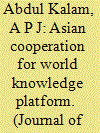

|
|
|
| 4 |
ID:
170106
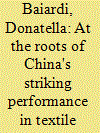

|
|
|
|
|
| Summary/Abstract |
This paper analyzes the determinants of China's striking performance in textile exports in the time period 2001–2016. We integrate the analysis by Lall and Albaladejo (World Development, 2004), based only on China and its main Asian competitors' market share dynamics, by estimating an extended version of a traditional export function, derived from the imperfect substitute model, including a proxy of non-price competitiveness. The key long-run elasticities for each Asian exporter are thus computed and discussed in a panel-data framework, and the different export performances are examined taking into account the interaction between the estimated parameters and the growth rates of relative prices, foreign demand and product quality. Lastly, we decompose the textile export growth differences between China and its rivals into the three main channels of trade competition, i.e. price, quantity and quality. Our findings show that China is crowding out most of its rivals with a competitive strategy based on a mix of low and decreasing relative prices and non-price policies aiming at stimulating export volumes. However, certain weaknesses in the Chinese trade prospects emerge when quality improvement is considered.
|
|
|
|
|
|
|
|
|
|
|
|
|
|
|
|
| 5 |
ID:
183565


|
|
|
|
|
| Summary/Abstract |
Curbing climate change is gaining increasing consensus globally. While many countries seek to set carbon prices, significant price dispersion and policy stringency continue to raise concerns about competitiveness. To address this issue, the EU has proposed a carbon border adjustment mechanism (CBAM), which aims to level the playing field by levying a carbon price on EU imports. In this paper, we estimate the competitiveness and welfare impacts of the EU CBAM, based on a refined multi-regional IO approach. We quantify changes in the value of exports to the EU market upon CBAM implementation for both EU members and non-EU economies. It is found that the EU CBAM will lead to a redistribution of competitiveness among countries and regions. Specifically, it is estimated that EU output would increase by 0.38 per cent while output in rest of the world decreases by 0.1 per cent in the short run, when CBAM is set at $US100/tCO2e. The burden is unevenly distributed among regions, with China, Russia and India bearing the most. Moreover, a deeper sub-national-level analysis on China shows that, given its pervasive domestic production network, income losses in landlocked provinces exceed their export losses, contrasting with the pattern for trade-exposed provinces.
|
|
|
|
|
|
|
|
|
|
|
|
|
|
|
|
| 6 |
ID:
143523


|
|
|
|
|
| Summary/Abstract |
A key strength of Canada’s international education engagement is its openness to a multi-faceted exchange of knowledge and ideas across borders. But while Canada excels and continues to grow in international research collaboration, institutional partnerships, and inbound student mobility, its performance in the realm of outbound mobility is less impressive: a mere 3.1 percent of university students participate annually. Participation of college and high school students is even lower. This paper looks at recent developments in Canada and six other countries and regions to compare approaches regarding international learning experiences. It first examines the Canadian situation, then the various rationales for a high degree of participation in education abroad, followed by a review of international approaches. It concludes that Canada needs to redouble its efforts and investments or young Canadians will be less equipped to participate than their peers from other countries.
|
|
|
|
|
|
|
|
|
|
|
|
|
|
|
|
| 7 |
ID:
127302
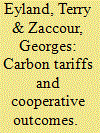

|
|
|
|
|
| Publication |
2014.
|
| Summary/Abstract |
In the absence of an international environmental agreement (IEA) on climate change, a country may be reluctant to unilaterally implement environmental actions, as this may lead to the relocation of firms to other, lax-on-pollution countries. To avoid this problem, while still taking care of the environment, a country may impose a carbon tariff that adjusts for the differences between its own carbon tax and the other country's tax. We consider two countries with a representative firm in each one, and characterize and contrast the equilibrium strategies and outcomes in three scenarios. In the first (benchmark) scenario, in a first stage the regulators in the two countries determine the carbon taxes noncooperatively, and in a second stage, the firms compete à la Cournot. In the second scenario, the regulators cooperate in determining the carbon taxes, while the firms still play a noncooperative Cournot game. In the third scenario, we add another player, e.g., the World Trade Organization, which announced a border tax in a prior stage; the game is then played as in the first scenario. Our two major results are (i) a border-tax adjustment (BTA) mimics quite well the cooperative solution in setting the carbon taxes as in scenario two. This means that a BTA may be a way around the lack of enthusiasm for an IEA. (ii) All of our simulations show that a partial correction of the difference in taxes is sufficient to maximize total welfare. In short, the conclusion is that a BTA may be used as a credible threat to achieve an outcome that is very close to the cooperative outcome.
|
|
|
|
|
|
|
|
|
|
|
|
|
|
|
|
| 8 |
ID:
082246
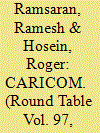

|
|
|
|
|
| Publication |
2008.
|
| Summary/Abstract |
The article examines economic performance in the CARICOM Region against the background of the challenges facing the growth of both regional and international trade. It argues that CARICOM has not only failed to create the expected dynamic in intra-regional trade but has also failed to lay the groundwork for a competitive and efficient manufacturing sector that could exploit foreign market opportunities in an increasingly transparent global economy. A strategy for greater competitiveness needs to embrace a broad range of non-price factors
|
|
|
|
|
|
|
|
|
|
|
|
|
|
|
|
| 9 |
ID:
079668
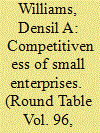

|
|
|
|
|
| Publication |
2007.
|
| Summary/Abstract |
The rapid liberalization of the world's trading system has obliged all firms (micro, small, medium and large) to participate in the international trading system. The competitiveness of these enterprises is very important if developing economies are to secure their economic survival in this era of rapid market liberalization and erosion of trade preferences. This paper seeks to provide some insights into the competitiveness of a group of firms that have received very little attention in the debate on competitiveness and economic development. It draws on the case study method to analyse export-marketing strategies of eight small firms from Jamaica to help us analyse their ability to compete internationally and, by extension, to draw out lessons for other similar enterprises in the economy. The results reveal that the export-marketing strategies used by Jamaican small enterprises to expand exports are unsophisticated and unsustainable. The strategies pursued leave these enterprises hostage to foreign buyers, thus making their export capacity quite fickle. This therefore threatens their long-term survival and by extension the Jamaican economy. Taking greater control of the export-marketing mix is the only way these enterprises can develop sophisticated strategies that will ensure their survival in an increasingly inhospitable international trading environment
|
|
|
|
|
|
|
|
|
|
|
|
|
|
|
|
| 10 |
ID:
090813
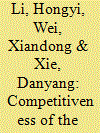

|
|
|
|
|
| Publication |
2009.
|
| Summary/Abstract |
Our assessment of the competitiveness of the Hong Kong economy from various perspectives indicates that the overall competitiveness of Hong Kong economy has been improving during the past several years. However, from a longer term historical perspective, there are still a number of areas in which Hong Kong's competitiveness has been eroded relative to her main competitors in East Asia, especially in export sector. On the aggregate level, although Hong Kong's total factor productivity (TFP) growth rate is amongst the best performers in East Asia in the recent years, it has been adversely affected by the continuing relocation of Hong Kong's manufacturing production to the Mainland China. On sectorial levels, Hong Kong's competitiveness deteriorated in several important categories of goods and service exports. Overall, our study shows that the Hong Kong economy still maintains its resilience to outside shocks, nevertheless it needs to explore new areas to fuel its future growth.
|
|
|
|
|
|
|
|
|
|
|
|
|
|
|
|
| 11 |
ID:
111458


|
|
|
|
|
| Publication |
2012.
|
| Summary/Abstract |
In Iran, there are more than 15,000 MW of wind power potential, but only about 90 MW have been installed since 2009. Because fuel costs are the main part of fuel-consumed power generation costs and fossil resource costs are highly subsidized in Iran, renewable energies such as wind power have yet to be fully developed. This analysis sets out to evaluate the total generating costs of wind power and conventional power plants in Iran. A levelized cost approach was conducted that included investment costs, O&M costs, fuel costs and external costs of emissions for each type of technology. Comparison of cost assessments of power generation show that by taking into account global fuel prices and incorporating air pollutant externalities, wind power can be as competitive as conventional power plants. This paper suggests that a subsidies targeting law would significantly affect the development of the Iranian wind power industry in the future.
|
|
|
|
|
|
|
|
|
|
|
|
|
|
|
|
| 12 |
ID:
102100


|
|
|
|
|
| Publication |
2010.
|
| Summary/Abstract |
The paper analyzes the economic, political and social factors of the impact from the internal and external environment on the competitiveness of defense-industry enterprises.
|
|
|
|
|
|
|
|
|
|
|
|
|
|
|
|
| 13 |
ID:
086609
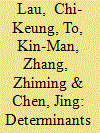

|
|
|
|
|
| Publication |
2009.
|
| Summary/Abstract |
This paper attempts to explore key determinants of competitiveness in the textile and apparel industries, with special reference to Chinese Mainland. The authors conduct a survey that is designed to use productivity, supply-side and demand-side determinants to measure enterprises' competitiveness. The collected survey data is then analyzed using factor analysis to capture the related determining factors indicative of competitiveness at the enterprise level. The findings demonstrate that government policies and related industry infrastructure are the most important determinants of competitiveness in the textile and apparel industries, followed by domestic demand. This suggests that the improvement of industry infrastructure can foster industry performance, and that more resources should be endowed to enhance the domestic business competitiveness of local enterprises. The development of domestic demand will foster the competitiveness of the textile and apparel industries on a more sustainable basis.
|
|
|
|
|
|
|
|
|
|
|
|
|
|
|
|
| 14 |
ID:
151325
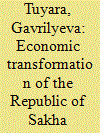

|
|
|
| 15 |
ID:
143529
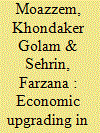

|
|
|
|
|
| Summary/Abstract |
Bangladesh’s success in the global apparel value chain following the expiration of the Multi-Fibre Arrangement in 2005 deserves study to understand how a least developed country can become a major source of apparels within a short period of time. This article shows that even under a quasi-hierarchical governance structure, suppliers in Bangladesh have made significant progress in economic upgrading, particularly process and product upgrading. Competitive pressure linked to the ‘open sourcing’ of apparels has caused leading firms to ease conditionalities on the production process. Preferential access to major markets, timely responses to buyers’ changing demands, favourable policies related to the import of raw materials, production and export of apparels and new labour-related policies have facilitated economic upgrading. Suppliers have accordingly benefited from substantial investment in productive capacity, technological know-how and workers’ skills. Further upgrading would require more investment in firm-level productivity and improvement in physical and social compliance.
|
|
|
|
|
|
|
|
|
|
|
|
|
|
|
|
| 16 |
ID:
092549


|
|
|
|
|
| Publication |
2009.
|
| Summary/Abstract |
The increase in oil prices in recent years has occurred concurrently with a rapid expansion of Chinese exports in the world markets, despite China being an oil importing country. In this paper we develop a theoretical model that explains the positive correlation between Chinese exports and the oil price. The model shows that Chinese growth can lead to an increase in oil prices that has a stronger impact on its export competitors. This is due to the large labor force surplus of China. We then examine this hypothesis by estimating a reduced form equation for Chinese exports using Rodrik [Rodrik, Dani, 2006. What's so special about China's exports? China and World Economy 14, 1-19.]'s measure of export competitiveness, together with the oil price, productivity, real exchange rate, and foreign industrial production over the monthly 1992-2005 period. The results suggest a stable relationship and yields slightly positive values for the price of oil and elastic coefficients for export competitiveness, along with the expected negative elasticity for the real exchange rate.
|
|
|
|
|
|
|
|
|
|
|
|
|
|
|
|
| 17 |
ID:
108705
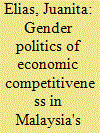

|
|
|
|
|
| Publication |
2011.
|
| Summary/Abstract |
Many academic commentators have pointed to how the widening and deepening of a neoliberal reform agenda in Southeast Asia has brought about the end of developmental forms of state governance and the emergence of less directly market interventionist states pursuing economic 'competitiveness'. In this paper, I note how notions of competitiveness are increasingly fused with ideas regarding the contribution of gender equity and women's empowerment to national economic success. However, drawing upon a case study of Malaysia, this paper highlights how government policies stressing both the marketisation of social reproduction and the need to expand women's productive roles are constantly brought into tension with embedded social structures. Such an emphasis is essential to any understanding of the role of the Malaysian state in economic development - a role that has been fundamentally shaped by a localised politics of ethnicity. The paper draws upon examples from government policy-making that conceptualise women as key workers in the emerging knowledge-driven economy and as microentrepreneurs driving pro-poor economic growth and illustrates how such policies are brought into tension with traditionalist discourses concerning the appropriate role of women in society.
|
|
|
|
|
|
|
|
|
|
|
|
|
|
|
|
| 18 |
ID:
087021
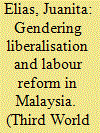

|
|
|
|
|
| Publication |
2009.
|
| Summary/Abstract |
This paper seeks to examine how and why gender needs to be brought into the analysis of state developmentalism in Asia. In doing so, the paper focuses on ongoing processes of labour market and industrial relations reform that have accompanied Malaysia's economic development since the early 1970s. Understanding these reforms from a gender perspective means that we must recognise both the significant contribution that women make to the growth of export manufacturing industries and the role that social relations of reproduction play in underpinning economic reform and transformation. The analysis explores how gendered social relations (of production and reproduction) have been central to the labour politics of Malaysia's state-led developmentalism and how ideas of maintaining 'competitiveness' through the attempts to transition to a more knowledge-centred economy have entailed particular roles and responsibilities for women. Attempts to maintain economic competitiveness in Malaysia have rested upon ideas concerning the need to integrate women more fully into the formal labour market and a greater recognition of the contribution of social relations of reproduction to capitalist accumulation. The article discusses some of the tensions and contradictions that have emanated from this policy shift.
|
|
|
|
|
|
|
|
|
|
|
|
|
|
|
|
| 19 |
ID:
114045
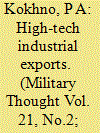

|
|
|
|
|
| Publication |
2012.
|
| Summary/Abstract |
The paper examines the strategic potential of foreign countries and Russia in the new markets of high-tech industrial products, shows the importance of competitiveness and technological advantages, and outlines the main vectors of competitive strategy to meet consumer demand for the output of military industry enterprises.
|
|
|
|
|
|
|
|
|
|
|
|
|
|
|
|
| 20 |
ID:
171890
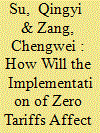

|
|
|
|
|
| Summary/Abstract |
This paper studies the employment effect of China’s possible implementation of zero tariffs by comparing China’s most-favored-nation tariffs and the tariff schedules of China’s signed free trade agreements (FTAs) with the tariff concessions in a typical high-standard FTA. It nds that there is a large gap between China’s current tariff status and a high-standard FTA, and the implementation of zero tariffs in China would have a signicant negative impact on employment in some industries. However, the employment effect of implementing zero tariffs is heterogeneous. Analysis at the industrial level shows that, although employment would drop in a few industries as a result of the implementation of zero tariffs, more jobs would be created in most industries. The overall employment effect of a zero tariff policy would be positive, creating an estimated 8.05 million jobs in China. Therefore, China should consider the adjustment costs brought by the labor movement in different industries and introduce relevant policies to deal with the employment shocks caused by zero tariffs.
|
|
|
|
|
|
|
|
|
|
|
|
|
|
|
|
|
|
|
|
|